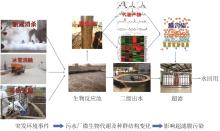Fouling in membrane bioreactors:An updated review
1
2017
... 我国污水厂二级出水深度处理与回用是大势所趋.2021年1月1日,国家发改委领衔十部委联合发布《关于推进污水资源化利用的指导意见》,对我国未来一段时期内污水回用规划做出了顶层设计,为全国市政污水厂的二级出水真正成为“城市第二水源”提供了强大的政策推力.为保障二级出水水质满足回用要求,超滤膜工艺被广泛应用,而保障该工艺长期稳定和经济运行的关键是有效的膜污染控制〔1-2〕.由于膜污染是水中有机污染物在膜表面与膜孔内形成的不可逆沉积所致,因此,长期以来对二级出水中有关膜污染的水质特征(水征)研究一直是热点话题〔3〕. ...
Ultrafiltration as tertiary treatment for municipal wastewater reuse
1
2021
... 我国污水厂二级出水深度处理与回用是大势所趋.2021年1月1日,国家发改委领衔十部委联合发布《关于推进污水资源化利用的指导意见》,对我国未来一段时期内污水回用规划做出了顶层设计,为全国市政污水厂的二级出水真正成为“城市第二水源”提供了强大的政策推力.为保障二级出水水质满足回用要求,超滤膜工艺被广泛应用,而保障该工艺长期稳定和经济运行的关键是有效的膜污染控制〔1-2〕.由于膜污染是水中有机污染物在膜表面与膜孔内形成的不可逆沉积所致,因此,长期以来对二级出水中有关膜污染的水质特征(水征)研究一直是热点话题〔3〕. ...
污水特质(水征)评价及其在污水再生处理工艺研究中的应用
1
2019
... 我国污水厂二级出水深度处理与回用是大势所趋.2021年1月1日,国家发改委领衔十部委联合发布《关于推进污水资源化利用的指导意见》,对我国未来一段时期内污水回用规划做出了顶层设计,为全国市政污水厂的二级出水真正成为“城市第二水源”提供了强大的政策推力.为保障二级出水水质满足回用要求,超滤膜工艺被广泛应用,而保障该工艺长期稳定和经济运行的关键是有效的膜污染控制〔1-2〕.由于膜污染是水中有机污染物在膜表面与膜孔内形成的不可逆沉积所致,因此,长期以来对二级出水中有关膜污染的水质特征(水征)研究一直是热点话题〔3〕. ...
污水特质(水征)评价及其在污水再生处理工艺研究中的应用
1
2019
... 我国污水厂二级出水深度处理与回用是大势所趋.2021年1月1日,国家发改委领衔十部委联合发布《关于推进污水资源化利用的指导意见》,对我国未来一段时期内污水回用规划做出了顶层设计,为全国市政污水厂的二级出水真正成为“城市第二水源”提供了强大的政策推力.为保障二级出水水质满足回用要求,超滤膜工艺被广泛应用,而保障该工艺长期稳定和经济运行的关键是有效的膜污染控制〔1-2〕.由于膜污染是水中有机污染物在膜表面与膜孔内形成的不可逆沉积所致,因此,长期以来对二级出水中有关膜污染的水质特征(水征)研究一直是热点话题〔3〕. ...
突发环境事件应急管理办法
1
... 当前,各类影响污水处理过程的突发环境事件频发.例如,由于新冠疫情突发需要大规模频繁使用消毒剂而造成的药剂短期大量排放,日均发生1~2起污水污泥偷排、有毒物质泄漏等人为环境事件,以及极端温度变化等自然灾害〔4〕.突发环境事件发生时,污水厂的进水水质或运行条件发生变化,造成对污水厂微生物生存环境的冲击,进而改变微生物代谢产物的时空分布,对膜污染效果产生重大影响(图1).笔者针对典型突发环境事件频发的新形势,以二级出水关键膜污染有机污染物为研究对象,综述了突发环境事件对其特征和后续超滤膜污染的影响,以期为超滤工艺在污水回用中的经济稳定运行提供参考. ...
污水二级生化出水有机物(EfOM)性质表征及去除研究现状
1
2011
... 污水厂二级出水有机物(EfOM)主要包含污水处理中的微生物代谢产物(SMPs)、人工合成有机物(如药品、杀虫剂、个人护理品等)、源于饮用水源的难降解有机物和少量非溶解态有机物(如浮游动物、细菌等),其中以SMPs所占比例最高〔5〕.EfOM的组分复杂,其中既包括蛋白质、多糖等大分子物质,也包括氨基酸、羧酸、醇、醛等小分子有机物〔6〕.因此,对EfOM中所有组分进行定量分析并不现实.近年来随着研究的深入,与膜污染相关的EfOM水征逐渐清晰. ...
污水二级生化出水有机物(EfOM)性质表征及去除研究现状
1
2011
... 污水厂二级出水有机物(EfOM)主要包含污水处理中的微生物代谢产物(SMPs)、人工合成有机物(如药品、杀虫剂、个人护理品等)、源于饮用水源的难降解有机物和少量非溶解态有机物(如浮游动物、细菌等),其中以SMPs所占比例最高〔5〕.EfOM的组分复杂,其中既包括蛋白质、多糖等大分子物质,也包括氨基酸、羧酸、醇、醛等小分子有机物〔6〕.因此,对EfOM中所有组分进行定量分析并不现实.近年来随着研究的深入,与膜污染相关的EfOM水征逐渐清晰. ...
Characterizing aquatic dissolved organic matter
1
2003
... 污水厂二级出水有机物(EfOM)主要包含污水处理中的微生物代谢产物(SMPs)、人工合成有机物(如药品、杀虫剂、个人护理品等)、源于饮用水源的难降解有机物和少量非溶解态有机物(如浮游动物、细菌等),其中以SMPs所占比例最高〔5〕.EfOM的组分复杂,其中既包括蛋白质、多糖等大分子物质,也包括氨基酸、羧酸、醇、醛等小分子有机物〔6〕.因此,对EfOM中所有组分进行定量分析并不现实.近年来随着研究的深入,与膜污染相关的EfOM水征逐渐清晰. ...
Low-pressure membrane filtration of secondary effluent in water reuse:Pre-treatment for fouling reduction
1
2008
... EfOM的分子质量分布(MW)已被证实与超滤膜污染有着较强的相关性.Linhua FAN等〔7〕对比了预过滤、混凝和阴离子交换树脂对EfOM膜污染的影响,结果表明EfOM中分子质量在40~70 ku的大分子有机物如溶解性微生物产物、蛋白质类物质等是导致膜污染的主要因素;Xing ZHENG等〔8〕采用LC-OCD-OND对超滤杯的进出水MW进行分析,不同水样的色谱图结果表明大分子胞外聚合物几乎完全被超滤膜截流,其含量与水样的膜阻正相关;R. K. HENDERSON等〔9〕对5种污水厂出水进行超滤实验,发现超滤工艺对大分子胞外聚合物的去除最为明显,表明大分子胞外聚合物是影响超滤膜污染的重要因素;K. JEONG等〔10〕研究表明臭氧可将EfOM中的部分大分子有机物(>5 ku)氧化降解为小分子有机物,从而减缓了后续超滤膜的通量下降. ...
Identification and quantification of major organic foulants in treated domestic wastewater affecting filterability in dead-end ultrafiltration
1
2009
... EfOM的分子质量分布(MW)已被证实与超滤膜污染有着较强的相关性.Linhua FAN等〔7〕对比了预过滤、混凝和阴离子交换树脂对EfOM膜污染的影响,结果表明EfOM中分子质量在40~70 ku的大分子有机物如溶解性微生物产物、蛋白质类物质等是导致膜污染的主要因素;Xing ZHENG等〔8〕采用LC-OCD-OND对超滤杯的进出水MW进行分析,不同水样的色谱图结果表明大分子胞外聚合物几乎完全被超滤膜截流,其含量与水样的膜阻正相关;R. K. HENDERSON等〔9〕对5种污水厂出水进行超滤实验,发现超滤工艺对大分子胞外聚合物的去除最为明显,表明大分子胞外聚合物是影响超滤膜污染的重要因素;K. JEONG等〔10〕研究表明臭氧可将EfOM中的部分大分子有机物(>5 ku)氧化降解为小分子有机物,从而减缓了后续超滤膜的通量下降. ...
Evaluation of effluent organic matter fouling in ultrafiltration treatment using advanced organic characterisation techniques
1
2011
... EfOM的分子质量分布(MW)已被证实与超滤膜污染有着较强的相关性.Linhua FAN等〔7〕对比了预过滤、混凝和阴离子交换树脂对EfOM膜污染的影响,结果表明EfOM中分子质量在40~70 ku的大分子有机物如溶解性微生物产物、蛋白质类物质等是导致膜污染的主要因素;Xing ZHENG等〔8〕采用LC-OCD-OND对超滤杯的进出水MW进行分析,不同水样的色谱图结果表明大分子胞外聚合物几乎完全被超滤膜截流,其含量与水样的膜阻正相关;R. K. HENDERSON等〔9〕对5种污水厂出水进行超滤实验,发现超滤工艺对大分子胞外聚合物的去除最为明显,表明大分子胞外聚合物是影响超滤膜污染的重要因素;K. JEONG等〔10〕研究表明臭氧可将EfOM中的部分大分子有机物(>5 ku)氧化降解为小分子有机物,从而减缓了后续超滤膜的通量下降. ...
Effects of ozonation and coagulation on effluent organic matter characteristics and ultrafiltration membrane fouling
1
2014
... EfOM的分子质量分布(MW)已被证实与超滤膜污染有着较强的相关性.Linhua FAN等〔7〕对比了预过滤、混凝和阴离子交换树脂对EfOM膜污染的影响,结果表明EfOM中分子质量在40~70 ku的大分子有机物如溶解性微生物产物、蛋白质类物质等是导致膜污染的主要因素;Xing ZHENG等〔8〕采用LC-OCD-OND对超滤杯的进出水MW进行分析,不同水样的色谱图结果表明大分子胞外聚合物几乎完全被超滤膜截流,其含量与水样的膜阻正相关;R. K. HENDERSON等〔9〕对5种污水厂出水进行超滤实验,发现超滤工艺对大分子胞外聚合物的去除最为明显,表明大分子胞外聚合物是影响超滤膜污染的重要因素;K. JEONG等〔10〕研究表明臭氧可将EfOM中的部分大分子有机物(>5 ku)氧化降解为小分子有机物,从而减缓了后续超滤膜的通量下降. ...
Fouling characteristics of wastewater effluent organic matter(EfOM) isolates on NF and UF membranes
1
2002
... 有机物的亲疏水性对有机物与膜之间、有机物之间的相互作用有重要影响,是影响EfOM超滤膜污染行为的重要因素.C. JARUSUTTHIRAK等〔11〕的研究结果表明EfOM中疏水性和过渡亲水性组分对超滤膜污染的影响小于胶体物质,但是其疏水作用力对疏水膜的通量下降起到重要作用;Xing ZHENG等〔12〕研究了不同EfOM组分对超滤膜污染的影响,结果表明疏水性有机酸和过渡亲水性物质与大分子胞外聚合物的相互作用可能会加重超滤膜污染;Kang XIAO等〔13〕研究表明膜的疏水性决定了膜污染的不可逆性,不同亲水性/疏水性组分的膜污染行为与膜的性质(疏水性、孔径等)相关;Rui MIAO等〔14〕利用原子力显微镜研究了不同EfOM组分与PVDF膜的相互作用力,发现亲水性EfOM组分对过滤初期的膜污染贡献较大,而疏水性组分对过滤后期的膜污染贡献较大. ...
Contribution of effluent organic matter(EfOM) to ultrafiltration(UF) membrane fouling:Isolation,characterization,and fouling effect of EfOM fractions
1
2014
... 有机物的亲疏水性对有机物与膜之间、有机物之间的相互作用有重要影响,是影响EfOM超滤膜污染行为的重要因素.C. JARUSUTTHIRAK等〔11〕的研究结果表明EfOM中疏水性和过渡亲水性组分对超滤膜污染的影响小于胶体物质,但是其疏水作用力对疏水膜的通量下降起到重要作用;Xing ZHENG等〔12〕研究了不同EfOM组分对超滤膜污染的影响,结果表明疏水性有机酸和过渡亲水性物质与大分子胞外聚合物的相互作用可能会加重超滤膜污染;Kang XIAO等〔13〕研究表明膜的疏水性决定了膜污染的不可逆性,不同亲水性/疏水性组分的膜污染行为与膜的性质(疏水性、孔径等)相关;Rui MIAO等〔14〕利用原子力显微镜研究了不同EfOM组分与PVDF膜的相互作用力,发现亲水性EfOM组分对过滤初期的膜污染贡献较大,而疏水性组分对过滤后期的膜污染贡献较大. ...
A systematic analysis of fouling evolution and irreversibility behaviors of MBR supernatant hydrophilic/hydrophobic fractions during microfiltration
1
2014
... 有机物的亲疏水性对有机物与膜之间、有机物之间的相互作用有重要影响,是影响EfOM超滤膜污染行为的重要因素.C. JARUSUTTHIRAK等〔11〕的研究结果表明EfOM中疏水性和过渡亲水性组分对超滤膜污染的影响小于胶体物质,但是其疏水作用力对疏水膜的通量下降起到重要作用;Xing ZHENG等〔12〕研究了不同EfOM组分对超滤膜污染的影响,结果表明疏水性有机酸和过渡亲水性物质与大分子胞外聚合物的相互作用可能会加重超滤膜污染;Kang XIAO等〔13〕研究表明膜的疏水性决定了膜污染的不可逆性,不同亲水性/疏水性组分的膜污染行为与膜的性质(疏水性、孔径等)相关;Rui MIAO等〔14〕利用原子力显微镜研究了不同EfOM组分与PVDF膜的相互作用力,发现亲水性EfOM组分对过滤初期的膜污染贡献较大,而疏水性组分对过滤后期的膜污染贡献较大. ...
Identifying polyvinylidene fluoride ultrafiltration membrane fouling behavior of different effluent organic matter fractions using colloidal probes
1
2014
... 有机物的亲疏水性对有机物与膜之间、有机物之间的相互作用有重要影响,是影响EfOM超滤膜污染行为的重要因素.C. JARUSUTTHIRAK等〔11〕的研究结果表明EfOM中疏水性和过渡亲水性组分对超滤膜污染的影响小于胶体物质,但是其疏水作用力对疏水膜的通量下降起到重要作用;Xing ZHENG等〔12〕研究了不同EfOM组分对超滤膜污染的影响,结果表明疏水性有机酸和过渡亲水性物质与大分子胞外聚合物的相互作用可能会加重超滤膜污染;Kang XIAO等〔13〕研究表明膜的疏水性决定了膜污染的不可逆性,不同亲水性/疏水性组分的膜污染行为与膜的性质(疏水性、孔径等)相关;Rui MIAO等〔14〕利用原子力显微镜研究了不同EfOM组分与PVDF膜的相互作用力,发现亲水性EfOM组分对过滤初期的膜污染贡献较大,而疏水性组分对过滤后期的膜污染贡献较大. ...
Fluorescence as a potential monitoring tool for recycled water systems:A review
1
2009
... 激发发射矩阵荧光光谱法(EEM)可用于分析水中荧光类有机物组分,其灵敏性高且便于实现在线监测,在水工业中受到了广泛的关注〔15〕.Huarong YU等〔16〕研究表明EfOM中的络氨酸类物质是造成超滤膜污染的主要污染物,可以作为膜污染的指示剂;E.FILLOUX等〔17〕研究发现EfOM中的腐殖酸类物质会加重超滤膜的不可逆污染;Q. V. LY等〔18〕报道了EfOM对混凝-超滤工艺中膜污染的影响,发现经过混凝/絮凝工艺后蛋白质类物质与可逆膜污染具有较强的相关性. ...
Understanding ultrafiltration membrane fouling by soluble microbial product and effluent organic matter using fluorescence excitation-emission matrix coupled with parallel factor analysis
1
2015
... 激发发射矩阵荧光光谱法(EEM)可用于分析水中荧光类有机物组分,其灵敏性高且便于实现在线监测,在水工业中受到了广泛的关注〔15〕.Huarong YU等〔16〕研究表明EfOM中的络氨酸类物质是造成超滤膜污染的主要污染物,可以作为膜污染的指示剂;E.FILLOUX等〔17〕研究发现EfOM中的腐殖酸类物质会加重超滤膜的不可逆污染;Q. V. LY等〔18〕报道了EfOM对混凝-超滤工艺中膜污染的影响,发现经过混凝/絮凝工艺后蛋白质类物质与可逆膜污染具有较强的相关性. ...
Investigating the relative contribution of colloidal and soluble fractions of secondary effluent organic matter to the irreversible fouling of MF and UF hollow fibre membranes
1
2016
... 激发发射矩阵荧光光谱法(EEM)可用于分析水中荧光类有机物组分,其灵敏性高且便于实现在线监测,在水工业中受到了广泛的关注〔15〕.Huarong YU等〔16〕研究表明EfOM中的络氨酸类物质是造成超滤膜污染的主要污染物,可以作为膜污染的指示剂;E.FILLOUX等〔17〕研究发现EfOM中的腐殖酸类物质会加重超滤膜的不可逆污染;Q. V. LY等〔18〕报道了EfOM对混凝-超滤工艺中膜污染的影响,发现经过混凝/絮凝工艺后蛋白质类物质与可逆膜污染具有较强的相关性. ...
Insights into the roles of recently developed coagulants as pretreatment to remove effluent organic matter for membrane fouling mitigation
1
2018
... 激发发射矩阵荧光光谱法(EEM)可用于分析水中荧光类有机物组分,其灵敏性高且便于实现在线监测,在水工业中受到了广泛的关注〔15〕.Huarong YU等〔16〕研究表明EfOM中的络氨酸类物质是造成超滤膜污染的主要污染物,可以作为膜污染的指示剂;E.FILLOUX等〔17〕研究发现EfOM中的腐殖酸类物质会加重超滤膜的不可逆污染;Q. V. LY等〔18〕报道了EfOM对混凝-超滤工艺中膜污染的影响,发现经过混凝/絮凝工艺后蛋白质类物质与可逆膜污染具有较强的相关性. ...
Analytical methods for soluble microbial products(SMP) and extracellular polymers(ECP) in wastewater treatment systems:A review
1
2014
... 微生物代谢产物(SMP)是污水厂EfOM的重要组成部分〔19-21〕.SMP的生成过程受微生物生存状态决定,环境变化导致微生物代谢活动受到胁迫,会显著改变SMP的组分与特性,从而影响其膜污染行为.不同类型的突发环境事件对污水处理工艺中微生物代谢的影响不同,从而造成SMP成分的差异和EfOM膜污染行为的迥异. ...
Microbial products of activated sludge in biological wastewater treatment systems:A critical review
0
2012
Quantification of the inert chemical oxygen demand of raw wastewater and evaluation of soluble microbial product production in demo-scale upflow anaerobic sludge blanket reactors under different operational conditions
1
2009
... 微生物代谢产物(SMP)是污水厂EfOM的重要组成部分〔19-21〕.SMP的生成过程受微生物生存状态决定,环境变化导致微生物代谢活动受到胁迫,会显著改变SMP的组分与特性,从而影响其膜污染行为.不同类型的突发环境事件对污水处理工艺中微生物代谢的影响不同,从而造成SMP成分的差异和EfOM膜污染行为的迥异. ...
Acute impact of Hg2+,Cu2+,and Ag+ on the formation of biopolymers and nitrogenous soluble microbiological products in activated sludge for wastewater treatment
1
2020
... 因意外事故造成的有毒物质泄漏会造成污水厂进水水质的变化,可能会导致微生物代谢产物浓度升高和EfOM膜污染恶化.Tong LIU等〔22〕报道了铜、汞、银离子浓度的突然增加会促进大分子胞外聚合物和腐殖质类物质含量上升,这表明在铜、汞或银离子的胁迫下微生物会释放大量SMP并加剧后续膜污染;T. TRINH等〔23〕报道了氨氮冲击负荷造成的膜污染的可逆性明显高于其他突发事件,表明不同影响因素引发SMP组分的变化,造成膜污染效果迥异;T. MAQBOOL等〔24〕研究发现高盐度胁迫下SMP中会富集更多的容易引发膜污染的物质,如色氨酸类物质和大分子聚合物;Xing ZHENG等〔25〕系统研究了十多种重金属对微生物分泌和代谢产物的影响,发现不同重金属的效果差异显著,利用基因毒理分析技术转录效应水平指数(TELI)作为研究手段,进一步量化了膜应激、蛋白质抑制、氧化应激等相关的十余种基因对大分子聚合物、有机氮物质分泌的影响. ...
Hazardous events in membrane bioreactors-Part 1:Impacts on key operational and bulk water quality parameters
1
2016
... 因意外事故造成的有毒物质泄漏会造成污水厂进水水质的变化,可能会导致微生物代谢产物浓度升高和EfOM膜污染恶化.Tong LIU等〔22〕报道了铜、汞、银离子浓度的突然增加会促进大分子胞外聚合物和腐殖质类物质含量上升,这表明在铜、汞或银离子的胁迫下微生物会释放大量SMP并加剧后续膜污染;T. TRINH等〔23〕报道了氨氮冲击负荷造成的膜污染的可逆性明显高于其他突发事件,表明不同影响因素引发SMP组分的变化,造成膜污染效果迥异;T. MAQBOOL等〔24〕研究发现高盐度胁迫下SMP中会富集更多的容易引发膜污染的物质,如色氨酸类物质和大分子聚合物;Xing ZHENG等〔25〕系统研究了十多种重金属对微生物分泌和代谢产物的影响,发现不同重金属的效果差异显著,利用基因毒理分析技术转录效应水平指数(TELI)作为研究手段,进一步量化了膜应激、蛋白质抑制、氧化应激等相关的十余种基因对大分子聚合物、有机氮物质分泌的影响. ...
Changes in spectroscopic signatures in soluble microbial products of activated sludge under different osmotic stress conditions
1
2018
... 因意外事故造成的有毒物质泄漏会造成污水厂进水水质的变化,可能会导致微生物代谢产物浓度升高和EfOM膜污染恶化.Tong LIU等〔22〕报道了铜、汞、银离子浓度的突然增加会促进大分子胞外聚合物和腐殖质类物质含量上升,这表明在铜、汞或银离子的胁迫下微生物会释放大量SMP并加剧后续膜污染;T. TRINH等〔23〕报道了氨氮冲击负荷造成的膜污染的可逆性明显高于其他突发事件,表明不同影响因素引发SMP组分的变化,造成膜污染效果迥异;T. MAQBOOL等〔24〕研究发现高盐度胁迫下SMP中会富集更多的容易引发膜污染的物质,如色氨酸类物质和大分子聚合物;Xing ZHENG等〔25〕系统研究了十多种重金属对微生物分泌和代谢产物的影响,发现不同重金属的效果差异显著,利用基因毒理分析技术转录效应水平指数(TELI)作为研究手段,进一步量化了膜应激、蛋白质抑制、氧化应激等相关的十余种基因对大分子聚合物、有机氮物质分泌的影响. ...
Impact of heavy metals on the formation and properties of solvable microbiological products released from activated sludge in biological wastewater treatment
1
2020
... 因意外事故造成的有毒物质泄漏会造成污水厂进水水质的变化,可能会导致微生物代谢产物浓度升高和EfOM膜污染恶化.Tong LIU等〔22〕报道了铜、汞、银离子浓度的突然增加会促进大分子胞外聚合物和腐殖质类物质含量上升,这表明在铜、汞或银离子的胁迫下微生物会释放大量SMP并加剧后续膜污染;T. TRINH等〔23〕报道了氨氮冲击负荷造成的膜污染的可逆性明显高于其他突发事件,表明不同影响因素引发SMP组分的变化,造成膜污染效果迥异;T. MAQBOOL等〔24〕研究发现高盐度胁迫下SMP中会富集更多的容易引发膜污染的物质,如色氨酸类物质和大分子聚合物;Xing ZHENG等〔25〕系统研究了十多种重金属对微生物分泌和代谢产物的影响,发现不同重金属的效果差异显著,利用基因毒理分析技术转录效应水平指数(TELI)作为研究手段,进一步量化了膜应激、蛋白质抑制、氧化应激等相关的十余种基因对大分子聚合物、有机氮物质分泌的影响. ...
COVID-19 rarely spreads through surfaces. So why are we still deep cleaning?
1
2021
... 公共卫生事件如新冠疫情带来的区域大规模消杀,使得排入污水厂的含活性氯等消毒物质显著增加〔26〕.这些种类、浓度不一的消毒剂会对污水厂带来怎样的影响,尤其是对SMP组分和特征的影响,现在尚缺乏系统的研究与评估.Zhongbo ZHOU等〔27〕对比了次氯酸钠对三种大分子有机物(EfOM中的大分子聚合物、牛血清蛋白和右旋糖酐)性质和官能团的影响,结果表明次氯酸钠剂量的增加会降低EfOM中大分子聚合物的含量,但是可能会增加牛血清蛋白的分子质量;Xiaoliang LI等〔28〕的研究表明不同种类的氧化型和非氧化型杀菌剂对微生物的毒性差异大,这可能会引发不同的微生物效应,带来微生物代谢产物的显著变化,影响膜污染水征有机物的组分和浓度. ...
Chemically induced alterations in the characteristics of fouling-causing bio-macromolecules-Implications for the chemical cleaning of fouled membranes
1
2017
... 公共卫生事件如新冠疫情带来的区域大规模消杀,使得排入污水厂的含活性氯等消毒物质显著增加〔26〕.这些种类、浓度不一的消毒剂会对污水厂带来怎样的影响,尤其是对SMP组分和特征的影响,现在尚缺乏系统的研究与评估.Zhongbo ZHOU等〔27〕对比了次氯酸钠对三种大分子有机物(EfOM中的大分子聚合物、牛血清蛋白和右旋糖酐)性质和官能团的影响,结果表明次氯酸钠剂量的增加会降低EfOM中大分子聚合物的含量,但是可能会增加牛血清蛋白的分子质量;Xiaoliang LI等〔28〕的研究表明不同种类的氧化型和非氧化型杀菌剂对微生物的毒性差异大,这可能会引发不同的微生物效应,带来微生物代谢产物的显著变化,影响膜污染水征有机物的组分和浓度. ...
Treatment of cooling tower blowdown water by using adsorption-electrocatalytic oxidation:Technical performance,toxicity assessment and economic evaluation
1
2020
... 公共卫生事件如新冠疫情带来的区域大规模消杀,使得排入污水厂的含活性氯等消毒物质显著增加〔26〕.这些种类、浓度不一的消毒剂会对污水厂带来怎样的影响,尤其是对SMP组分和特征的影响,现在尚缺乏系统的研究与评估.Zhongbo ZHOU等〔27〕对比了次氯酸钠对三种大分子有机物(EfOM中的大分子聚合物、牛血清蛋白和右旋糖酐)性质和官能团的影响,结果表明次氯酸钠剂量的增加会降低EfOM中大分子聚合物的含量,但是可能会增加牛血清蛋白的分子质量;Xiaoliang LI等〔28〕的研究表明不同种类的氧化型和非氧化型杀菌剂对微生物的毒性差异大,这可能会引发不同的微生物效应,带来微生物代谢产物的显著变化,影响膜污染水征有机物的组分和浓度. ...
Application and microbial ecology of psychrotrophs in domestic wastewater treatment at low temperature
1
2018
... 近年来,极端气候事件发生频率增加,其中对污水厂运行影响较为严重的是气温骤降导致的进水温度剧变.在急剧的水温波动条件下,污水厂中常规的嗜温菌代谢活动受到严重影响,而嗜冷菌仍可以保持较高的有机物去除效率〔29〕.Chen TAO等〔30〕报道了低温会导致SBR反应器中大分子聚合物浓度升高,且胞外多糖对温度的敏感性高于蛋白质,该研究成果表明低温条件可能会加剧EfOM的膜污染;P. KRZEMINSKI等〔31〕研究表明低温使得膜生物反应器中微生物量降低,污水中有机物的生物降解作用减弱,低温条件下污水中大量的胶体和溶解性组分均是造成膜污染的重要因素;P. VAN DEN BRINK等〔32〕研究表明低温使得活性污泥释放了更多的大分子多糖和小分子物质,这是造成低温条件下膜污染加剧且可逆性降低的原因之一. ...
Characterization and modelling of soluble microbial products in activated sludge systems treating municipal wastewater with special emphasis on temperature effect
1
2021
... 近年来,极端气候事件发生频率增加,其中对污水厂运行影响较为严重的是气温骤降导致的进水温度剧变.在急剧的水温波动条件下,污水厂中常规的嗜温菌代谢活动受到严重影响,而嗜冷菌仍可以保持较高的有机物去除效率〔29〕.Chen TAO等〔30〕报道了低温会导致SBR反应器中大分子聚合物浓度升高,且胞外多糖对温度的敏感性高于蛋白质,该研究成果表明低温条件可能会加剧EfOM的膜污染;P. KRZEMINSKI等〔31〕研究表明低温使得膜生物反应器中微生物量降低,污水中有机物的生物降解作用减弱,低温条件下污水中大量的胶体和溶解性组分均是造成膜污染的重要因素;P. VAN DEN BRINK等〔32〕研究表明低温使得活性污泥释放了更多的大分子多糖和小分子物质,这是造成低温条件下膜污染加剧且可逆性降低的原因之一. ...
Impact of temperature on raw wastewater composition and activated sludge filterability in full-scale MBR systems for municipal sewage treatment
1
2012
... 近年来,极端气候事件发生频率增加,其中对污水厂运行影响较为严重的是气温骤降导致的进水温度剧变.在急剧的水温波动条件下,污水厂中常规的嗜温菌代谢活动受到严重影响,而嗜冷菌仍可以保持较高的有机物去除效率〔29〕.Chen TAO等〔30〕报道了低温会导致SBR反应器中大分子聚合物浓度升高,且胞外多糖对温度的敏感性高于蛋白质,该研究成果表明低温条件可能会加剧EfOM的膜污染;P. KRZEMINSKI等〔31〕研究表明低温使得膜生物反应器中微生物量降低,污水中有机物的生物降解作用减弱,低温条件下污水中大量的胶体和溶解性组分均是造成膜污染的重要因素;P. VAN DEN BRINK等〔32〕研究表明低温使得活性污泥释放了更多的大分子多糖和小分子物质,这是造成低温条件下膜污染加剧且可逆性降低的原因之一. ...
Effect of temperature shocks on membrane fouling in membrane bioreactors
1
2011
... 近年来,极端气候事件发生频率增加,其中对污水厂运行影响较为严重的是气温骤降导致的进水温度剧变.在急剧的水温波动条件下,污水厂中常规的嗜温菌代谢活动受到严重影响,而嗜冷菌仍可以保持较高的有机物去除效率〔29〕.Chen TAO等〔30〕报道了低温会导致SBR反应器中大分子聚合物浓度升高,且胞外多糖对温度的敏感性高于蛋白质,该研究成果表明低温条件可能会加剧EfOM的膜污染;P. KRZEMINSKI等〔31〕研究表明低温使得膜生物反应器中微生物量降低,污水中有机物的生物降解作用减弱,低温条件下污水中大量的胶体和溶解性组分均是造成膜污染的重要因素;P. VAN DEN BRINK等〔32〕研究表明低温使得活性污泥释放了更多的大分子多糖和小分子物质,这是造成低温条件下膜污染加剧且可逆性降低的原因之一. ...
Toxic effect of heavy metals on the activated sludge protozoan community
1
1996
... 突发环境事件不仅会影响微生物的代谢活动,其对污水处理系统中微生物群落结构的影响也不可忽视.污水厂进水中有毒物质如重金属等浓度的升高会显著改变生物反应池中的微生物群落.污水系统中不同种类微生物对各类有毒物质的敏感性不同〔33〕,这是有毒物质改变污水厂微生物群落结构的根本原因.S. A. BHAT等〔34〕对比研究了铜、铅和二价镉对活性污泥微生物群落的影响,通过聚类分析和主成分分析发现不同种类重金属胁迫下活性污泥微生物的群落结构不同;Dongqi WANG等〔35〕探究了汞离子对序批式反应器中微生物群落和酶活性的影响,结果表明短期内汞离子浓度的骤升会导致马氏副球菌和胶团杆菌丰度降低. ...
Effect of heavy metals on the performance and bacterial profiles of activated sludge in a semi-continuous reactor
1
2020
... 突发环境事件不仅会影响微生物的代谢活动,其对污水处理系统中微生物群落结构的影响也不可忽视.污水厂进水中有毒物质如重金属等浓度的升高会显著改变生物反应池中的微生物群落.污水系统中不同种类微生物对各类有毒物质的敏感性不同〔33〕,这是有毒物质改变污水厂微生物群落结构的根本原因.S. A. BHAT等〔34〕对比研究了铜、铅和二价镉对活性污泥微生物群落的影响,通过聚类分析和主成分分析发现不同种类重金属胁迫下活性污泥微生物的群落结构不同;Dongqi WANG等〔35〕探究了汞离子对序批式反应器中微生物群落和酶活性的影响,结果表明短期内汞离子浓度的骤升会导致马氏副球菌和胶团杆菌丰度降低. ...
The effects of mercury shock on the performance and microorganisms in biological wastewater treatment process
1
2019
... 突发环境事件不仅会影响微生物的代谢活动,其对污水处理系统中微生物群落结构的影响也不可忽视.污水厂进水中有毒物质如重金属等浓度的升高会显著改变生物反应池中的微生物群落.污水系统中不同种类微生物对各类有毒物质的敏感性不同〔33〕,这是有毒物质改变污水厂微生物群落结构的根本原因.S. A. BHAT等〔34〕对比研究了铜、铅和二价镉对活性污泥微生物群落的影响,通过聚类分析和主成分分析发现不同种类重金属胁迫下活性污泥微生物的群落结构不同;Dongqi WANG等〔35〕探究了汞离子对序批式反应器中微生物群落和酶活性的影响,结果表明短期内汞离子浓度的骤升会导致马氏副球菌和胶团杆菌丰度降低. ...
Effects of microbial inactivation approaches on quantity and properties of extracellular polymeric substances in the process of wastewater treatment and reclamation:A review
1
2021
... 公共卫生事件可能造成过量消毒剂进入污水厂从而影响微生物群落.目前并没有与此直接相关的文献报道,然而已有研究表明消毒剂的存在确实会改变水中微生物的群落结构〔36〕.罗立炜等〔37〕研究表明甲基异噻唑酮(一种非氧化抗菌剂)抑制了反渗透系统中微生物的生长,但是也改变了微生物的群落结构并促进了胞外聚合物的释放;Haiya ZHANG等〔38〕研究了次氯酸钠和二氧化氯对再生水系统中微生物群落的影响,发现微生物群落的变化与消毒剂的种类、剂量及消毒时间相关. ...
甲基异噻唑琳酮对MBR出水微生物生长分泌特性及群落结构的影响
1
2019
... 公共卫生事件可能造成过量消毒剂进入污水厂从而影响微生物群落.目前并没有与此直接相关的文献报道,然而已有研究表明消毒剂的存在确实会改变水中微生物的群落结构〔36〕.罗立炜等〔37〕研究表明甲基异噻唑酮(一种非氧化抗菌剂)抑制了反渗透系统中微生物的生长,但是也改变了微生物的群落结构并促进了胞外聚合物的释放;Haiya ZHANG等〔38〕研究了次氯酸钠和二氧化氯对再生水系统中微生物群落的影响,发现微生物群落的变化与消毒剂的种类、剂量及消毒时间相关. ...
甲基异噻唑琳酮对MBR出水微生物生长分泌特性及群落结构的影响
1
2019
... 公共卫生事件可能造成过量消毒剂进入污水厂从而影响微生物群落.目前并没有与此直接相关的文献报道,然而已有研究表明消毒剂的存在确实会改变水中微生物的群落结构〔36〕.罗立炜等〔37〕研究表明甲基异噻唑酮(一种非氧化抗菌剂)抑制了反渗透系统中微生物的生长,但是也改变了微生物的群落结构并促进了胞外聚合物的释放;Haiya ZHANG等〔38〕研究了次氯酸钠和二氧化氯对再生水系统中微生物群落的影响,发现微生物群落的变化与消毒剂的种类、剂量及消毒时间相关. ...
Effects of chlorination/chlorine dioxide disinfection on biofilm bacterial community and corrosion process in a reclaimed water distribution system
1
2019
... 公共卫生事件可能造成过量消毒剂进入污水厂从而影响微生物群落.目前并没有与此直接相关的文献报道,然而已有研究表明消毒剂的存在确实会改变水中微生物的群落结构〔36〕.罗立炜等〔37〕研究表明甲基异噻唑酮(一种非氧化抗菌剂)抑制了反渗透系统中微生物的生长,但是也改变了微生物的群落结构并促进了胞外聚合物的释放;Haiya ZHANG等〔38〕研究了次氯酸钠和二氧化氯对再生水系统中微生物群落的影响,发现微生物群落的变化与消毒剂的种类、剂量及消毒时间相关. ...
Short-term effect of temperature variation on the competition between PAOs and GAOs during acclimation period of an EBPR system
1
2011
... 温度是影响微生物群落的重要环境因子,极端气候事件造成的污水厂水温波动对微生物群落结构的影响不容忽视.Nanqi REN等〔39〕研究了温度冲击对强化生物除磷系统中聚磷菌(PAOs)和聚糖菌(GAOs)的影响,结果表明温度冲击对PAOs丰度的影响要大于对GAOs,GAOs可以更好地适应温度变化并在(14±1) ℃条件下处于主导地位;W.AHMED等〔40〕探究了低温冲击对移动床膜生物反应器中微生物群落的影响,Beta多样性分析表明当水温从10 ℃降至1 ℃生物膜上的微生物群落发生明显转变;C. S. COURAS等〔41〕对比了水温、水力条件和进水脂肪冲击对升流式厌氧污泥床中微生物的影响,结果表明温度对单胞菌科的影响程度最大. ...
Microbial response of nitrifying biofilms to cold-shock
1
2020
... 温度是影响微生物群落的重要环境因子,极端气候事件造成的污水厂水温波动对微生物群落结构的影响不容忽视.Nanqi REN等〔39〕研究了温度冲击对强化生物除磷系统中聚磷菌(PAOs)和聚糖菌(GAOs)的影响,结果表明温度冲击对PAOs丰度的影响要大于对GAOs,GAOs可以更好地适应温度变化并在(14±1) ℃条件下处于主导地位;W.AHMED等〔40〕探究了低温冲击对移动床膜生物反应器中微生物群落的影响,Beta多样性分析表明当水温从10 ℃降至1 ℃生物膜上的微生物群落发生明显转变;C. S. COURAS等〔41〕对比了水温、水力条件和进水脂肪冲击对升流式厌氧污泥床中微生物的影响,结果表明温度对单胞菌科的影响程度最大. ...
Effects of operational shocks on key microbial populations for biogas production in UASB(Upflow Anaerobic Sludge Blanket) reactors
1
2014
... 温度是影响微生物群落的重要环境因子,极端气候事件造成的污水厂水温波动对微生物群落结构的影响不容忽视.Nanqi REN等〔39〕研究了温度冲击对强化生物除磷系统中聚磷菌(PAOs)和聚糖菌(GAOs)的影响,结果表明温度冲击对PAOs丰度的影响要大于对GAOs,GAOs可以更好地适应温度变化并在(14±1) ℃条件下处于主导地位;W.AHMED等〔40〕探究了低温冲击对移动床膜生物反应器中微生物群落的影响,Beta多样性分析表明当水温从10 ℃降至1 ℃生物膜上的微生物群落发生明显转变;C. S. COURAS等〔41〕对比了水温、水力条件和进水脂肪冲击对升流式厌氧污泥床中微生物的影响,结果表明温度对单胞菌科的影响程度最大. ...






 津公网安备 12010602120337号
津公网安备 12010602120337号